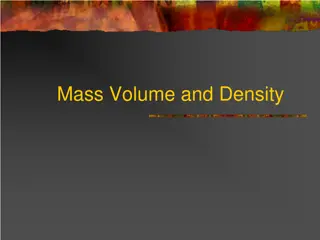Understanding Mass Spectrometry Principles and Applications
Mass spectrometry is a powerful analytical technique used to determine the molecular mass, formula, and structural features of compounds. By ionizing molecules in a mass spectrometer, it generates molecular ions that reveal valuable information about the composition of the compound. Isotope peaks help in identifying elements like carbon and halogens, while fragmentation rules aid in analyzing different compounds. Explore the world of mass spectrometry through ionization, molecular ion peaks, isotope abundance calculations, and fragmentation patterns.
Download Presentation

Please find below an Image/Link to download the presentation.
The content on the website is provided AS IS for your information and personal use only. It may not be sold, licensed, or shared on other websites without obtaining consent from the author. Download presentation by click this link. If you encounter any issues during the download, it is possible that the publisher has removed the file from their server.
E N D
Presentation Transcript
MASS SPECTROMETRY - PRINCIPLE Mass spectrometry allows us to determine the molecular mass and the molecular formula of a compound, as well as certain structural features of the compound. In mass spectrometry, a small sample of a compound is introduced into an instrument called a mass spectrometer, where it is vaporized and then ionized as a result of an electron s being removed from each molecule. Ionization can be accomplished in several ways. The most common method bombards the vaporized molecules with a beam of high-energy electrons. The energy of the electron beam can be varied, but a beam of about 70 electron volts (eV) is commonly used. When the electron beam hits a molecule, it knocks out an electron, producing a molecular ion, which is a radical cation a species with an unpaired electron and a positive charge.
Molecular ion peak: Molecular weight of the compound Base Peak
Calculating the Relative Abundance of Isotope Peaks
Calculating the Relative Abundance of Isotope Peaks
Applications of Isotope Peaks (i) To calculate the number of CARBON atoms (ii) To calculate the number of halogens like Cl & Br M+2 peak 3:1 M+2 peak 1:1 Chlorine Bromine
Rules For Fragmentation in MS MS of n-Pentane MS of Isopentane
McLafferty Rearrangement
IONIZATION TECHNIQUES EI: Electron Impact CI: Chemical Ionisation
Chemical Ionization (CI) The vapourized sample is introduced in to the mass spectropeter with an excess of a reagent gas (commonly) at a pressure of about 1 torr. The excess carrier gas is ionized by electron impact to the primary ions CH4.+and CH3+. These react with the excess methane to give secondary ions.
Field Desorption (FD) Stable molecular ions are obtained from volatility, which is placed on the anode of a pair of electrodes, between which there is an intense electric field. a sample of low Desorption occurs, and molecular and quasimolecular ions are produced with insufficient internal fragmentation. energy for extensive Usually the major peak represents the [M+H]+ion. Synthetic polymers with molecular weights on the order of 10,000 Da have been analyzed, but there is a much lower molecular weight limit for polar biopolymers.























